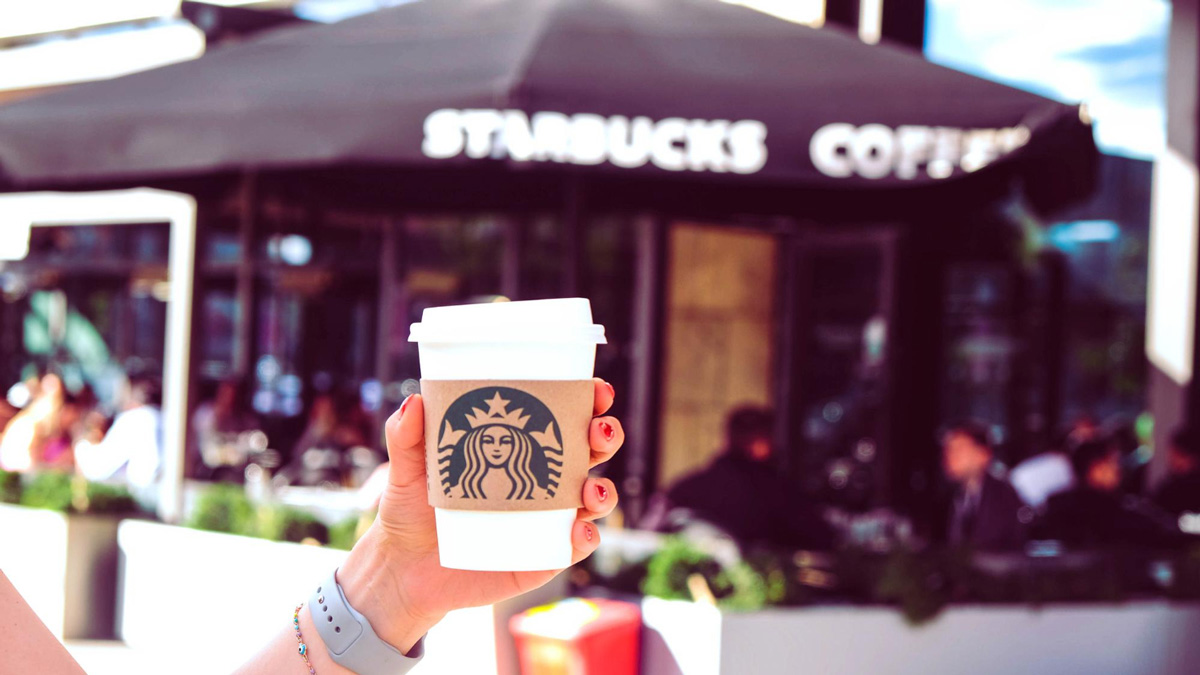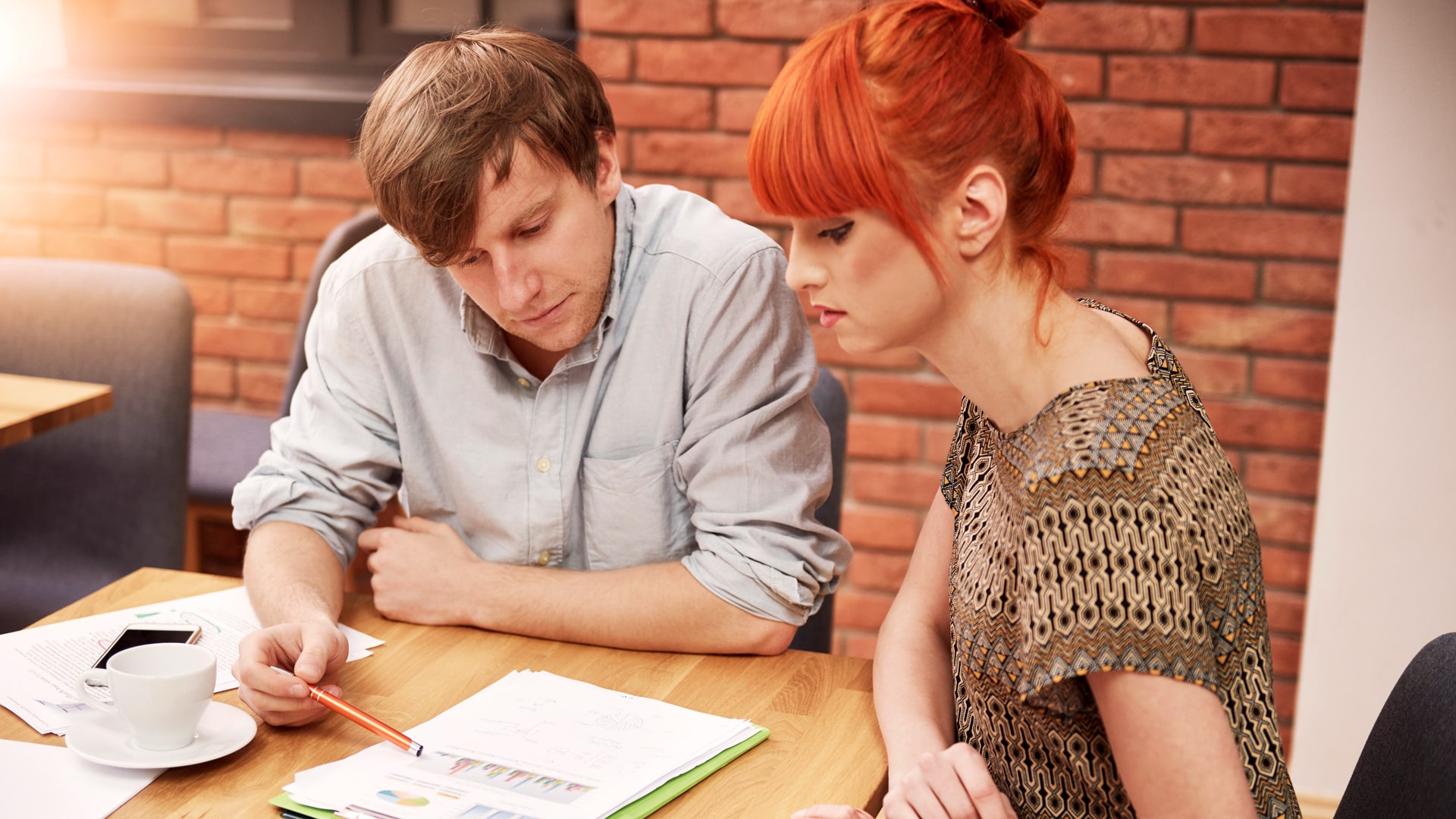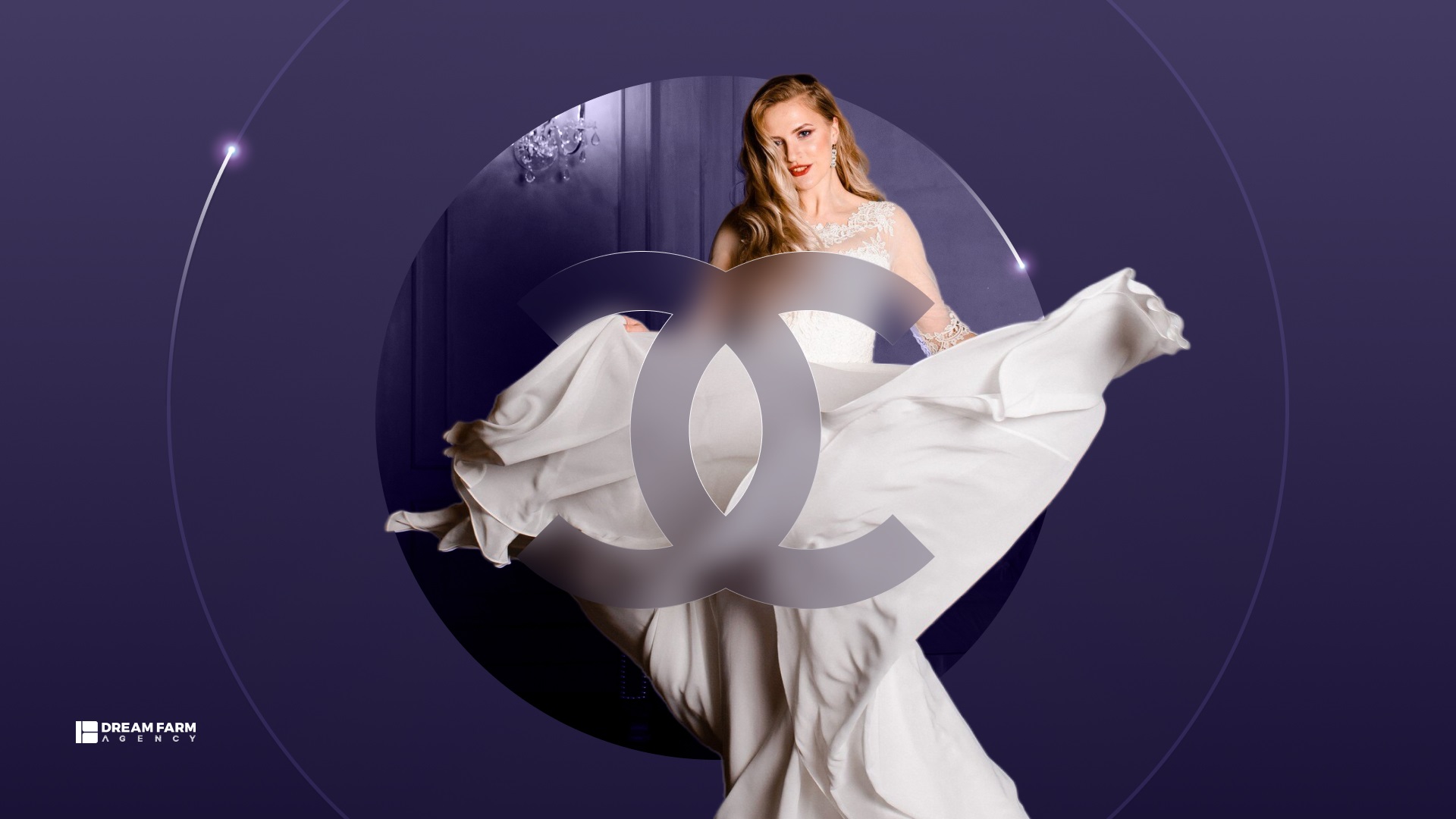
- A brief history of brand archetypes
- Brands can have more than 1 archetype
- What are 12 brand archetypes?
- What are brand archetypes examples?
- Why are brand archetypes important?
- How to choose a brand archetype?
- Difference between archetypes and persona
- How Dream Farm Agency Can Help You Take Advantage of The powerful nature of brand archetypes
What comes to your mind when thinking about your best friend, or your colleague? You probably say they are funny, sophisticated, smart, etc. what you probably don’t know is that you are actually referring to your friend’s archetype. Archetypes have been around for a long time and brands have been using archetypes in their strategies to make people remember them how they want to be remembered.
A brief history of brand archetypes
In the 1940s, Carl Jung, a Swiss psychologist developed a set of brand archetypes and believed these archetypes to be an image that we know or remember others by. We subconsciously relate to these archetypes based on behavioral patterns, values, motivations and goals. He believed that people draw very close pictures in their minds when talking about a villain or a hero.
Brands are on the same boat. Over the years brands understood that in order to stand in a noisy world where businesses are growing by the seconds, they must represent an image to their audience. This is where archetypes come to play. Brands use archetypes in their branding, marketing and public relations so people can remember them by those archetypes. In fact, brand archetype is an essential part of every brand book.
But what are brand archetypes? And how brands can use them to drive success?
Brands can have more than 1 archetype
Before diving into 12 brand archetypes, we should talk about how many archetypes a brand can have? A brand is like a person, and much like people it can be multidimensional. A person can have multiple archetypes, or even different traits from different archetypes, but they usually have a dominant archetype that you remember them by. Brands can have multiple archetypes, and you can benefit from it by combining different archetypes and giving your brand more depth and complexity.
Lator down the road, you will read examples of brand archetypes. You might see some of them and say: “Hmmm, I think this brand is more Rebel than Creator”. Well, you are probably right. That brand can be a Rebel at heart, and a Creator at mind. We tried to make this post a one time stop for those who want to know about brand archetypes and cover different matters related to the subject, but odds are you will search more or even arrive at this post after reading a few articles. In those articles you might see brands we will mention in different categories. It’s because brands have different archetypes and each person chooses to see one side more clearly.
A successful brand is a brand that chooses to express itself with depth and craft a narrative for the audience to see it as different things through the journey. A good example would be Coca-Cola. While we listed Coca-Cola as a brand with Innocent archetype, it is also an Everyman (available to everyone, poor and rich, young and old, etc.) and Magician (use its secret formula and marketing to bring joy and amaze people). Now, let’s see what are those 12 brand archetypes you keep hearing about them.
What are 12 brand archetypes?
There are 12 brand archetypes based Carl Jung’s original theory, each with their own traits and patterns:
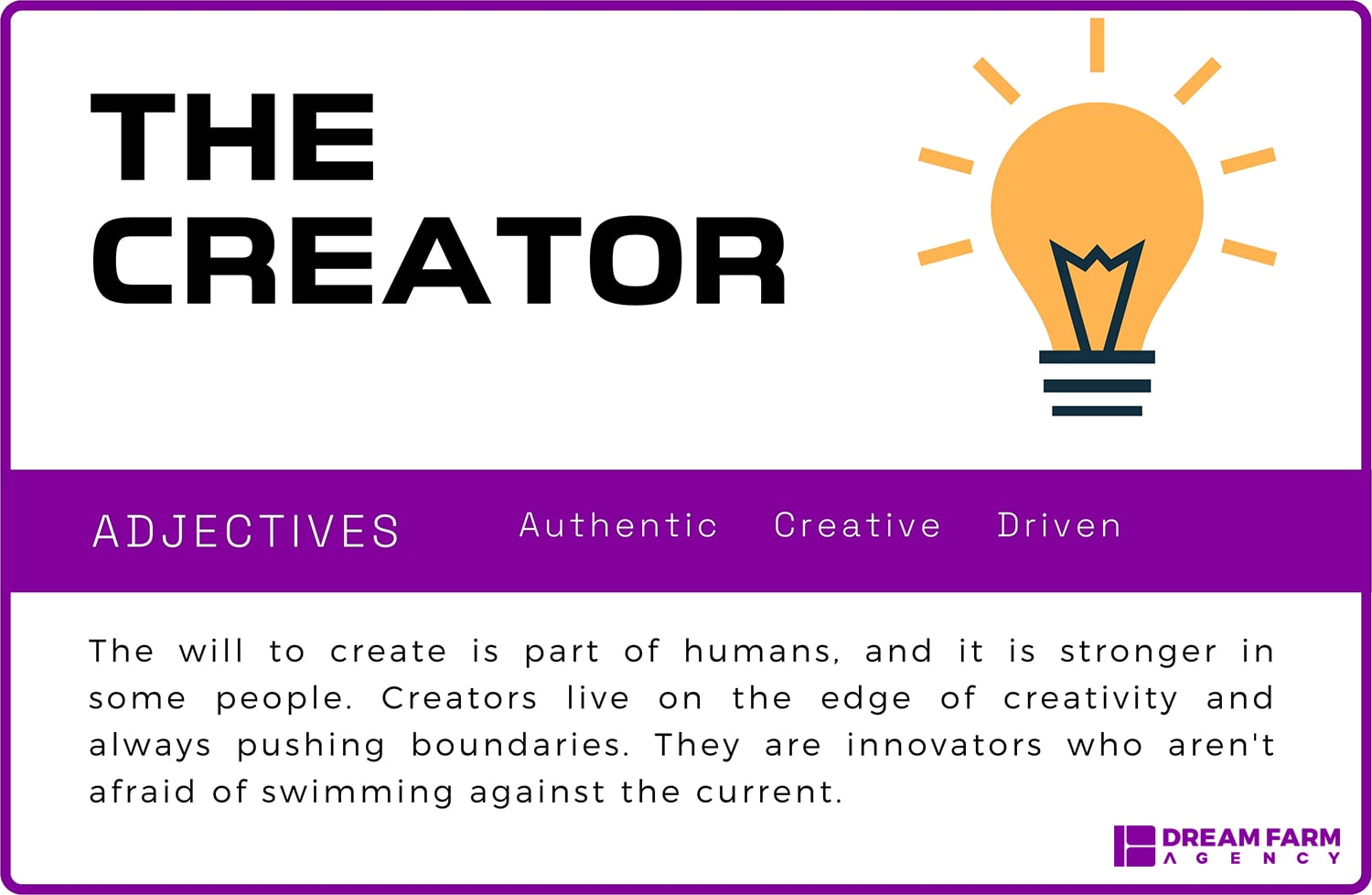
1.The Creator
The will to create is part of humans, and it is stronger in some people. Creators live on the edge of creativity and always pushing boundaries. They are innovators who aren’t afraid of swimming against the current. You often can see innovations in their products and services which stand different among a pool of competitors.
Brands with Creator Archetype bring new and original ideas to the table. They are visionaries shaping the future and often change the course of history.
Businesses in these industries usually are the creator type:
- Art and Design
- Technology and Internet
- Marketing (Digital and Traditional)

2.The Sage
The sage is thirsty for knowledge and seeks wisdom. Sages are guides that help and empower others to find their path and change the world. Sages don’t hesitate to share their knowledge and can be great mentors. A sage is a life-long learner and believes the quest to gain knowledge never stops. Sages don’t look to change the world, but inspire others to change it.
Businesses in these industries usually are the sage type:
- Educational Institutes
- Search Engines
- Encyclopedias
- Consultancy Agencies
- Analytics and Research Agencies
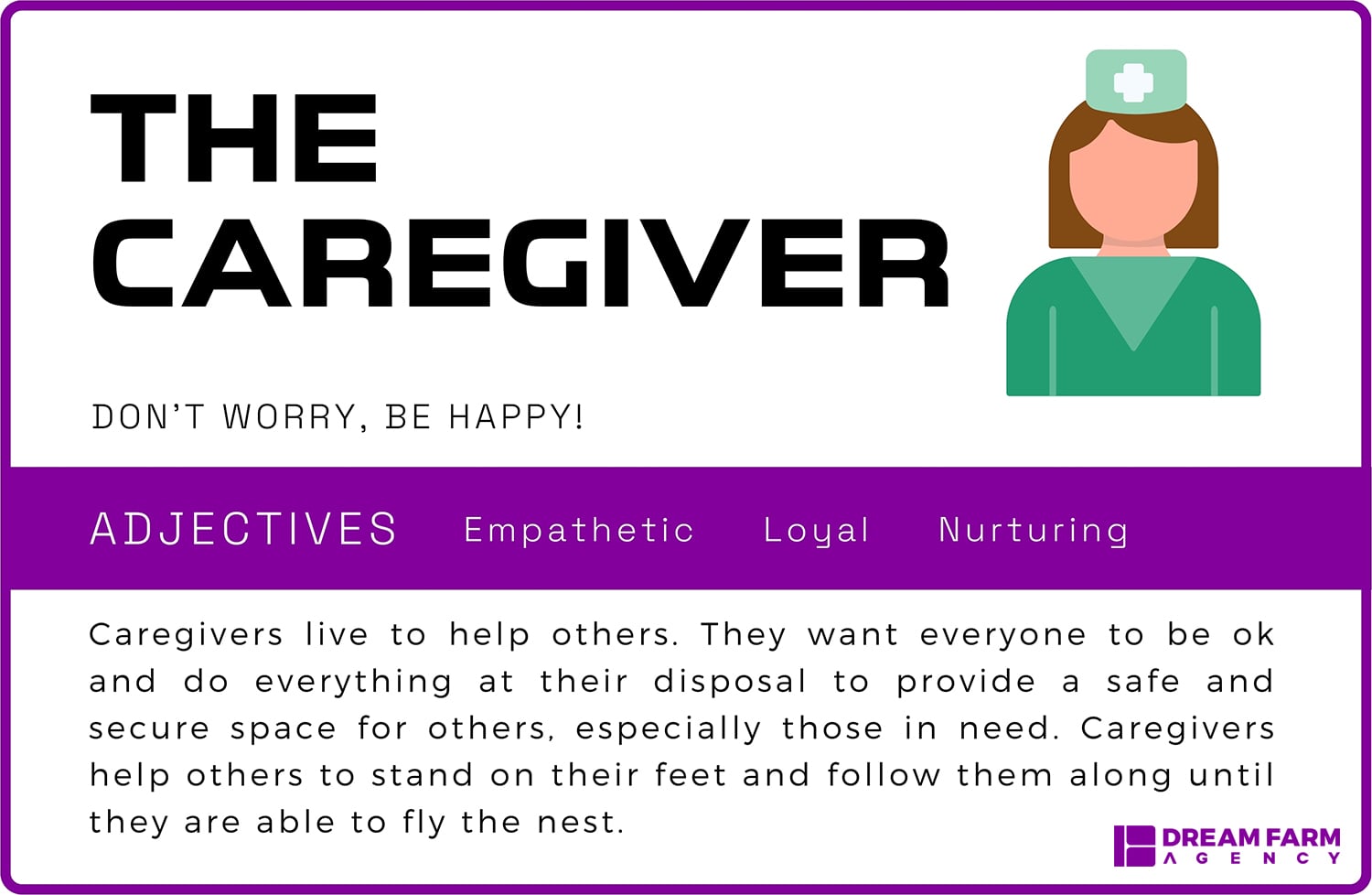
3.The Caregiver
Caregivers live to help others. They want everyone to be ok and do everything at their disposal to provide a safe and secure space for others, especially those in need. Caregivers help others to stand on their feet and follow them along until they are able to fly the nest. If you have an accident, caregivers rush to the scene to help and take necessary actions.
Businesses in these industries usually are the caregiver type:
- Healthcare
- Non Profits
- Insurance
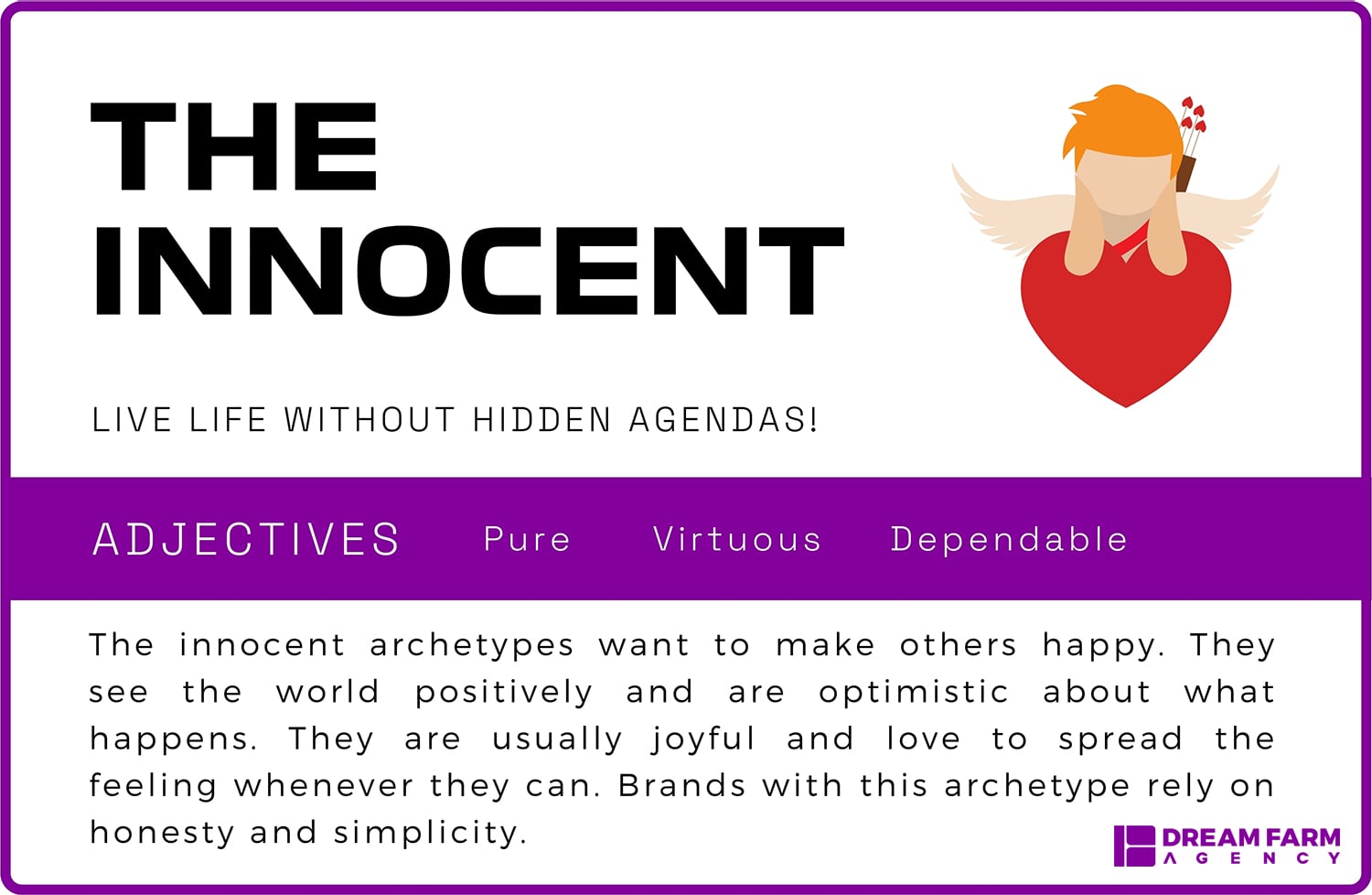
4.The Innocent
The innocent archetypes want to make others happy. They see the world positively and are optimistic about what happens. They are usually joyful and love to spread the feeling whenever they can. Brands with this archetype rely on honesty and simplicity. They see beauty in everyone and look for qualities inside every person.
Businesses in these industries usually are the Innocent type:
- Beauty and Skin care
- Organic foods
- Cleaning
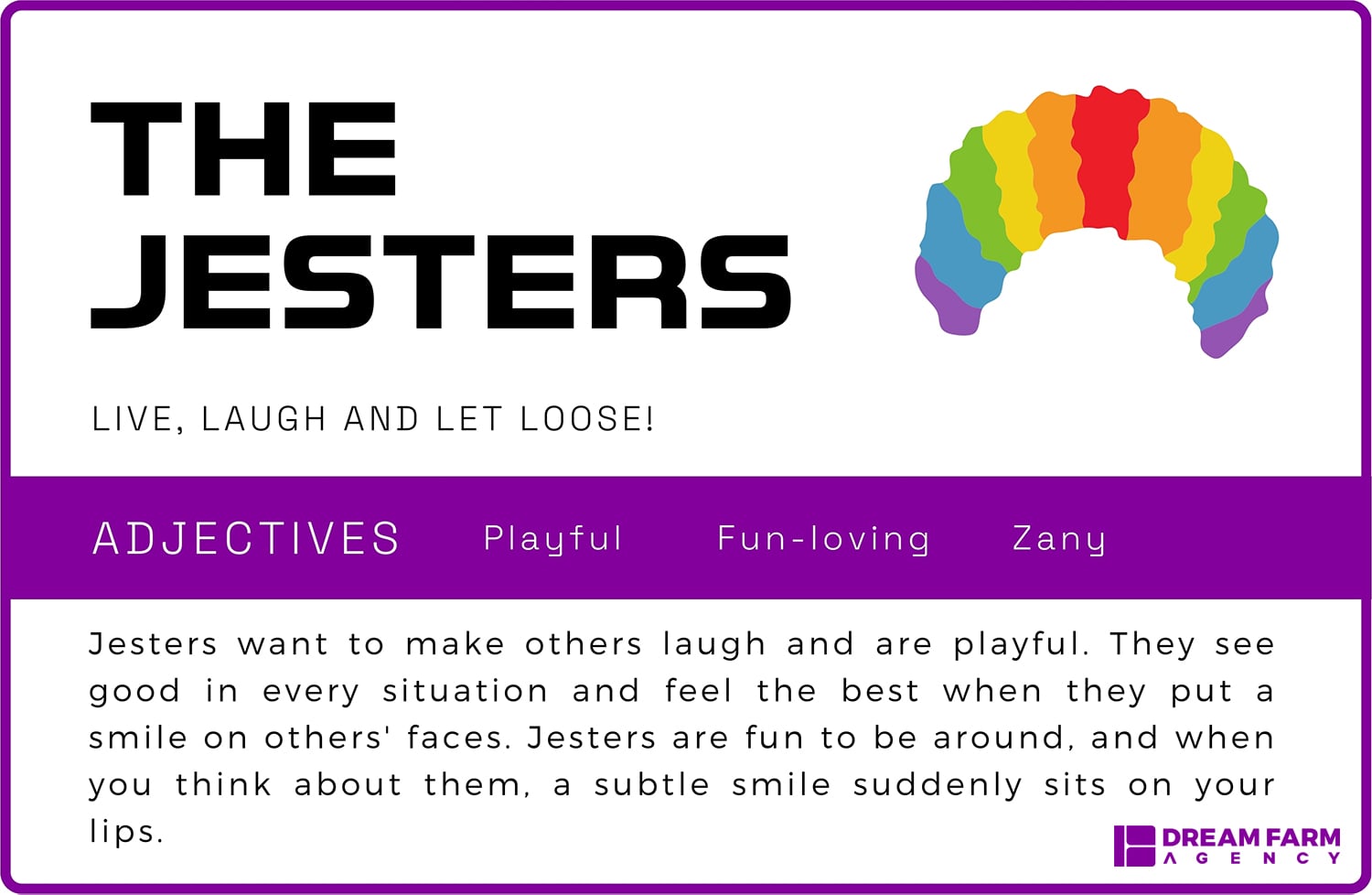
5.The Jester
Jesters want to make others laugh and are playful. They see good in every situation and feel the best when they put a smile on others’ faces. Jesters are fun to be around, and when you think about them, a subtle smile suddenly sits on your lips. They are the ones you usually refer to as “A child in a grown-up body”.
Businesses in these industries usually are the Jester type:
- Entertainment and Media
- Child and youth services
- Food and beverage
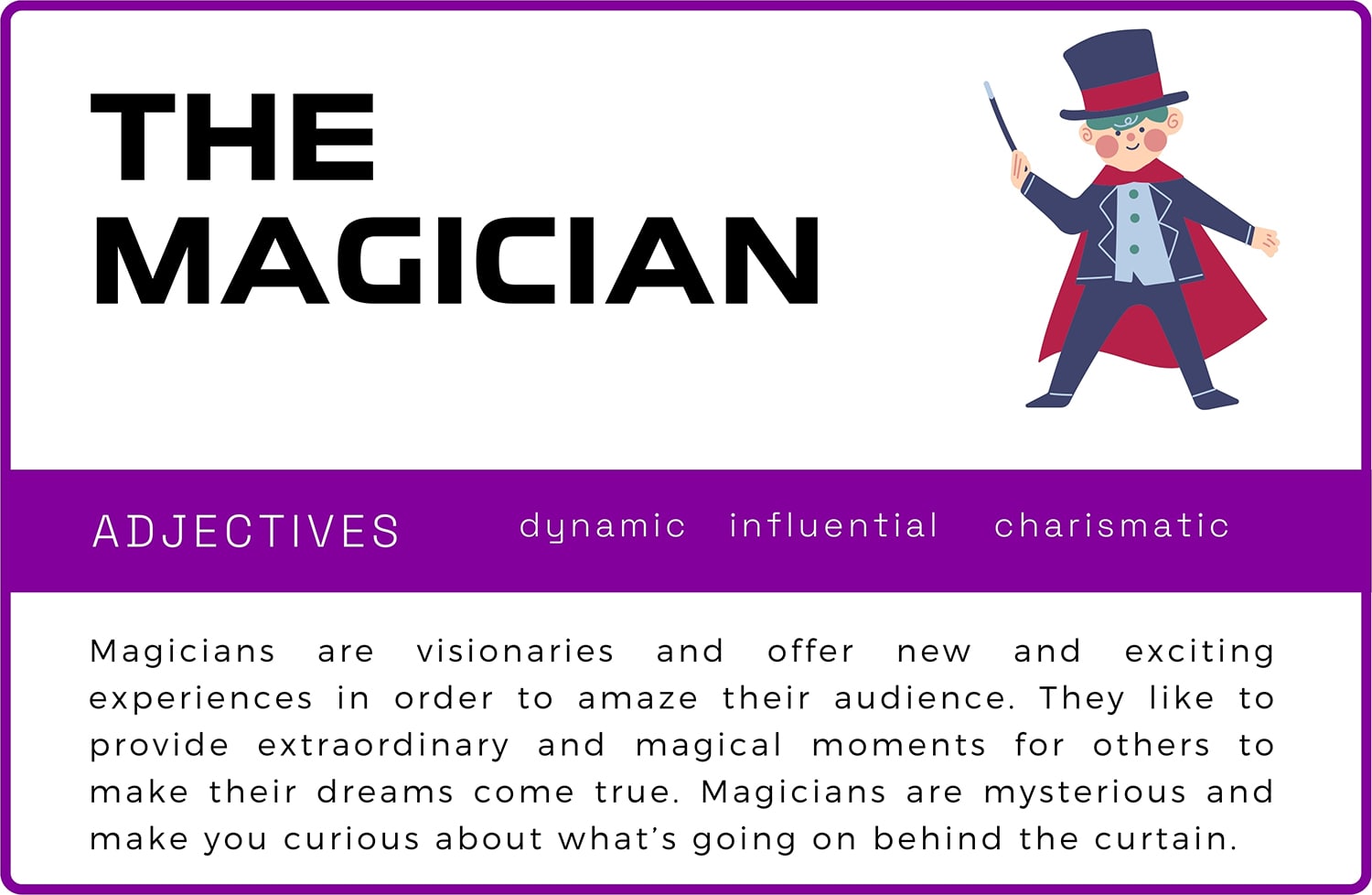
6.The Magician
Magicians are visionaries and offer new and exciting experiences in order to amaze their audience. They like to provide extraordinary and magical moments for others to make their dreams come true. Magicians are mysterious and make you curious about what’s going on behind the curtain. Magicians are knowledge seekers but unlike Sages, don’t share it with others. Istead, they use this knowledge to amaze and entertain others.
Businesses in these industries usually are the Magician type:
- Entertainment
- Beauty and Skin Care
- Well Being and Motivation
- Healthcare
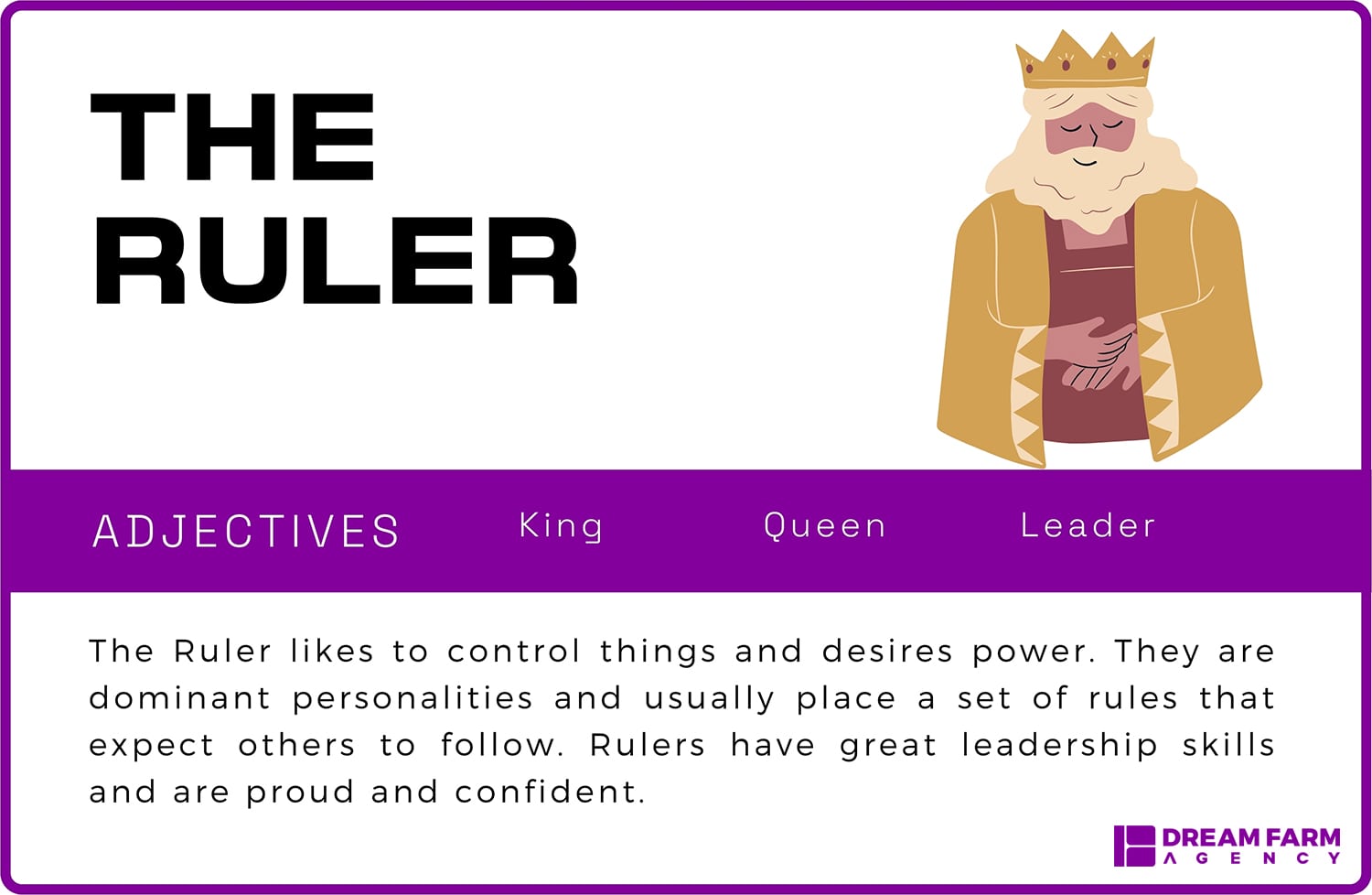
7.The Ruler
The Ruler likes to control things and desires power. They are dominant personalities and usually place a set of rules that expect others to follow. Rulers have great leadership skills and are proud and confident. They position themselves to be the leading force and do not appreciate being undermined. When confronting a Ruler, you feel intimidation and respect at the same time. When they are in the room, you feel their presence and everybody is silent when they talk.
Businesses in these industries usually are the Ruler type:
- Automobile and Transportation
- Steel and Petroleum
- Hotels and Resorts
- Cloths and wearabouts

8.The Hero
The hero has a clear line for right and wrong and wants to prevent or overcome injustice whenever possible. They are inspiring and achieve success through hard work. When facing a challenge, the hero doesn’t step back and learn required skills to solve it. They want to show the world that they can save it, and no matter how many times they fail, they rise again. Heroes are ambitious ones, and you can’t put strings on them.
Businesses in these industries usually are the Hero type:
- Sportswear are Sport Equipment
- Trades and Stock Exchanges
- Safety and Assurance
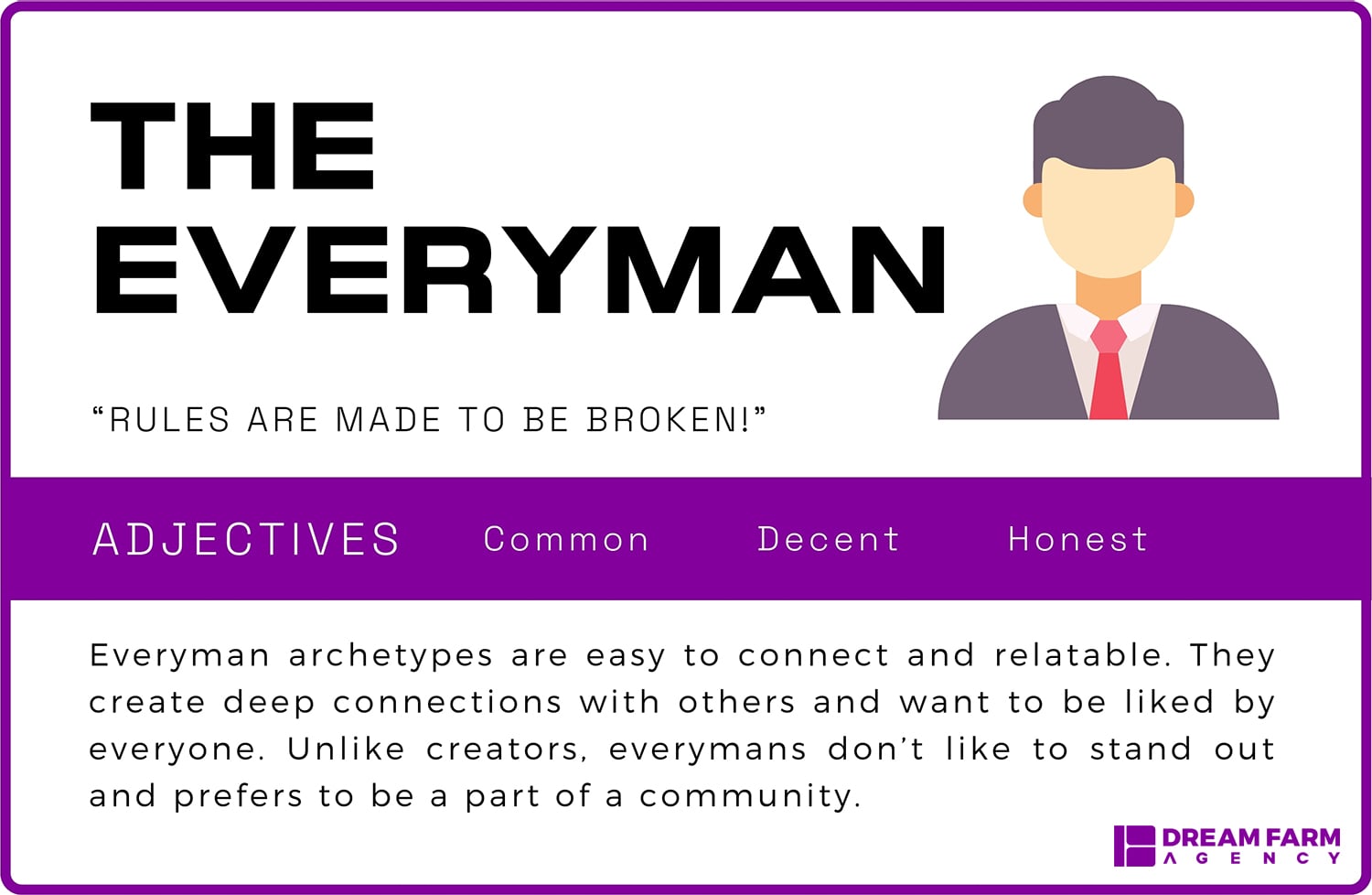
9.The Everyman (or Regular Guy)
Everyman archetypes are easy to connect and relatable. They create deep connections with others and want to be liked by everyone. Unlike creators, everymans don’t like to stand out and prefers to be a part of a community. They are friendly and you feel you can talk to them about anything like you know them for years. Everymans wants to fit in the group and that inspires them to be cautious when talking to others. There are very few things that don’t match their taste, but they are hardly passionate about anything.
Businesses in these industries usually are the Everyman type:
- Foods
- Chain Stores
- Manufacturers of low cost and cheap products
- Family-oriented Products

10.The Rebel (or Outlaw)
Rebels love to challenge the status quo and don’t follow the rules and standards. They are risk-takers with a great sense of uniqueness. Unlike everymans, they are not liked by everyone but usually create a cult-like following with strong loyalty among them. Rebels live for disruption. They strive to break traditional bonds and create a new wave. There is no peace with them, because peace means death for a rebel. They are revolutionaries who enjoy chaos and live for it.
Businesses in these industries usually are the Rebel type:
- Automobile
- Destruction and Demolition
- Fintech and Finance
- Technology and Internet

11.The Explorer
Explorers like to be free and value their independence. They are not afraid of challenges and meet head on. They like to explore areas that no one has explored before and have an adventurous spirit. For these brave souls, the journey to discovery never ends. You hardly find an explorer indoors. They are usually out there finding new locations and discovering new things.
Businesses in these industries usually are the Explorer type:
- Travel Agencies and camping
- Sportswear
- Automobile (Off-road)
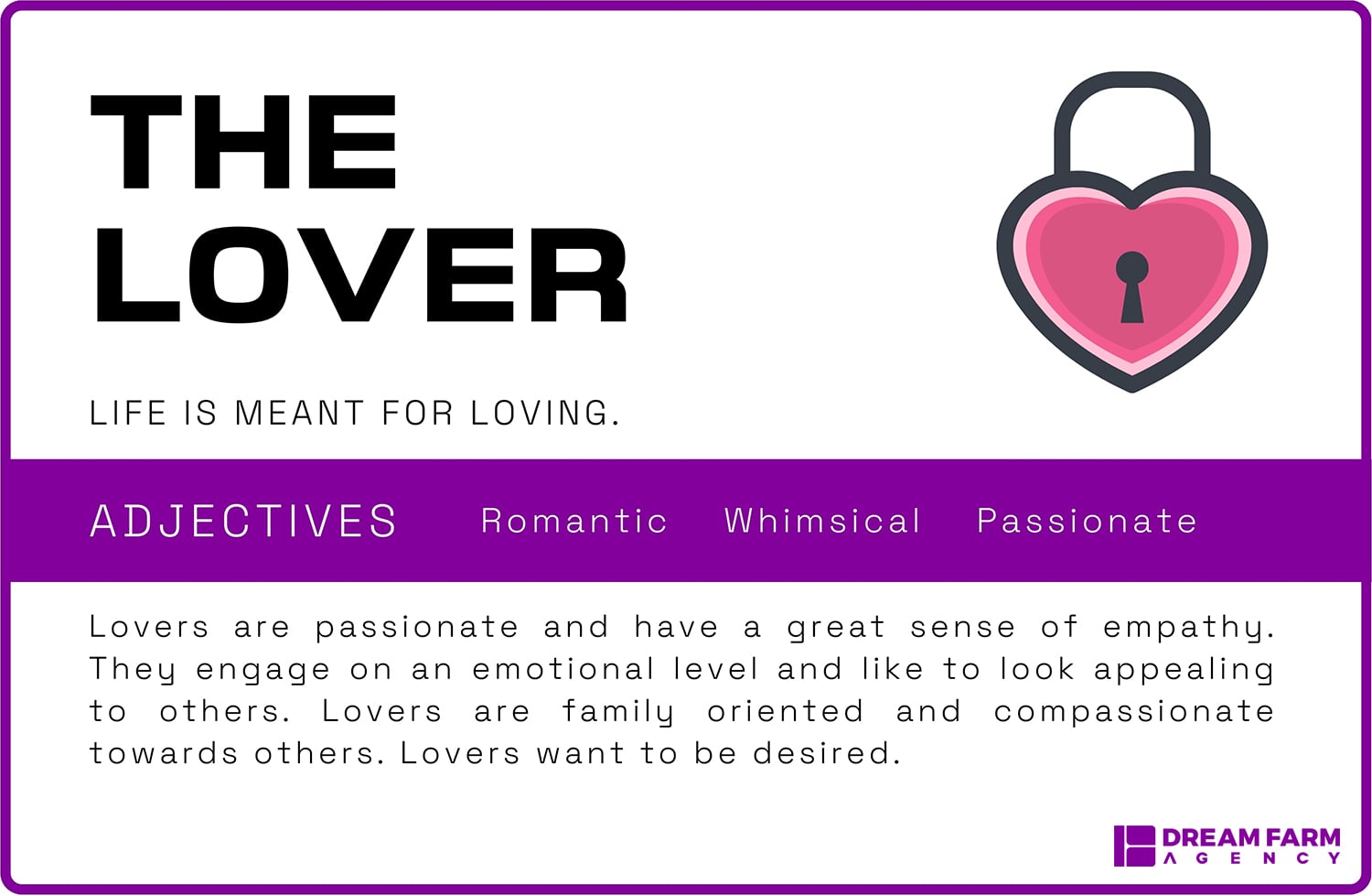
12.The Lover
Lovers are passionate and have a great sense of empathy. They engage on an emotional level and like to look appealing to others. Lovers are family oriented and compassionate towards others. Lovers want to be desired. This encourages them to work on their physical and Emotional appeal. They are very sensitive and have high emotional intelligence, which causes them to be more sensitive about what others say or do.
Businesses in these industries usually are the Lover type:
- Cosmetics and Beauty
- Foods and Restaurants
- Perfume and cologne
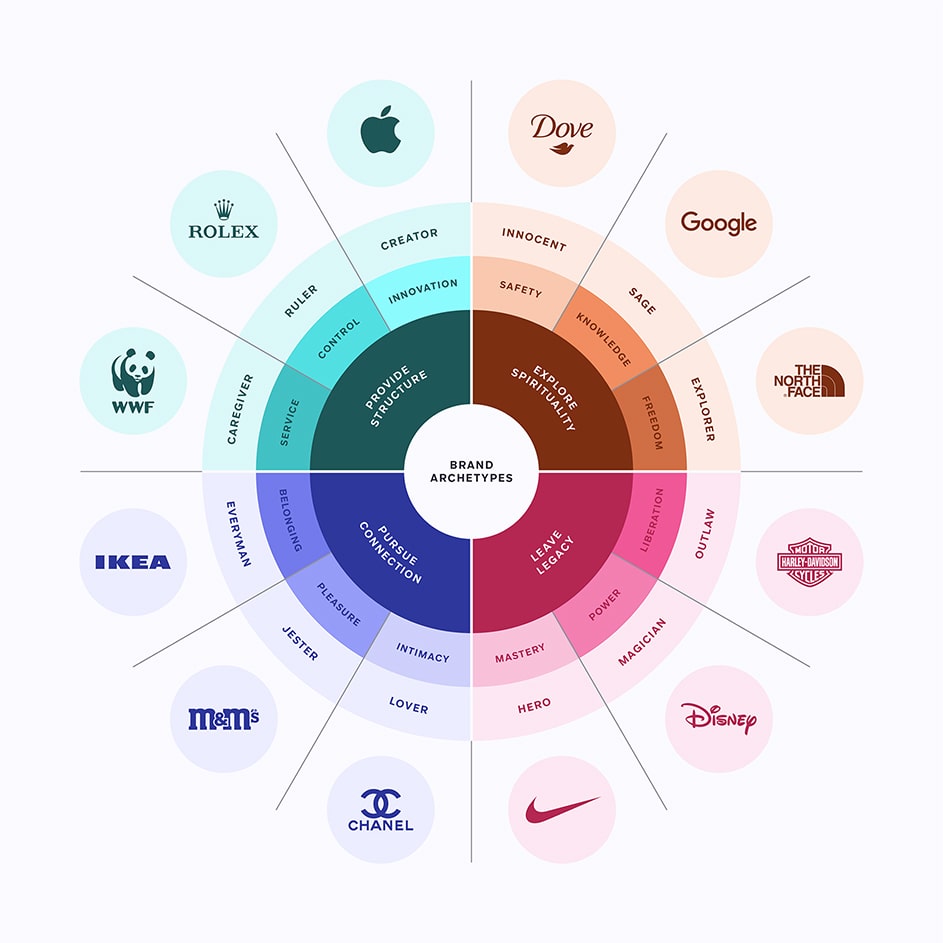
What are brand archetypes examples?
While you were reading about brand archetypes above, you probably had a few brands come to your mind. This is intentional, brands spend millions of dollars in order to put that image into your head. Let’s look at some of the brand archetypes out there:

Companies with Creator Archetype
Apple, Lego, Tesla and Adobe are best examples of brands with the Creator archetype. Products created by these brands are innovative and put an emphasis on creativity. Apple event celebrated creativity and craziness of innovation by its Think Different campaign.
Companies with Sage Archetype
Google, New York Times, National Geographic and TED are brands with sage archetype. While these brands might not have changed the world themselves, they provided valuable information to people who did.
Companies with Caregiver Archetype
Johnson And Johnson, Unicef, WWf and Toms are some of the companies with caregiver archetype. They seek to make the world a better place by helping those in need to stand up and continue the fight.
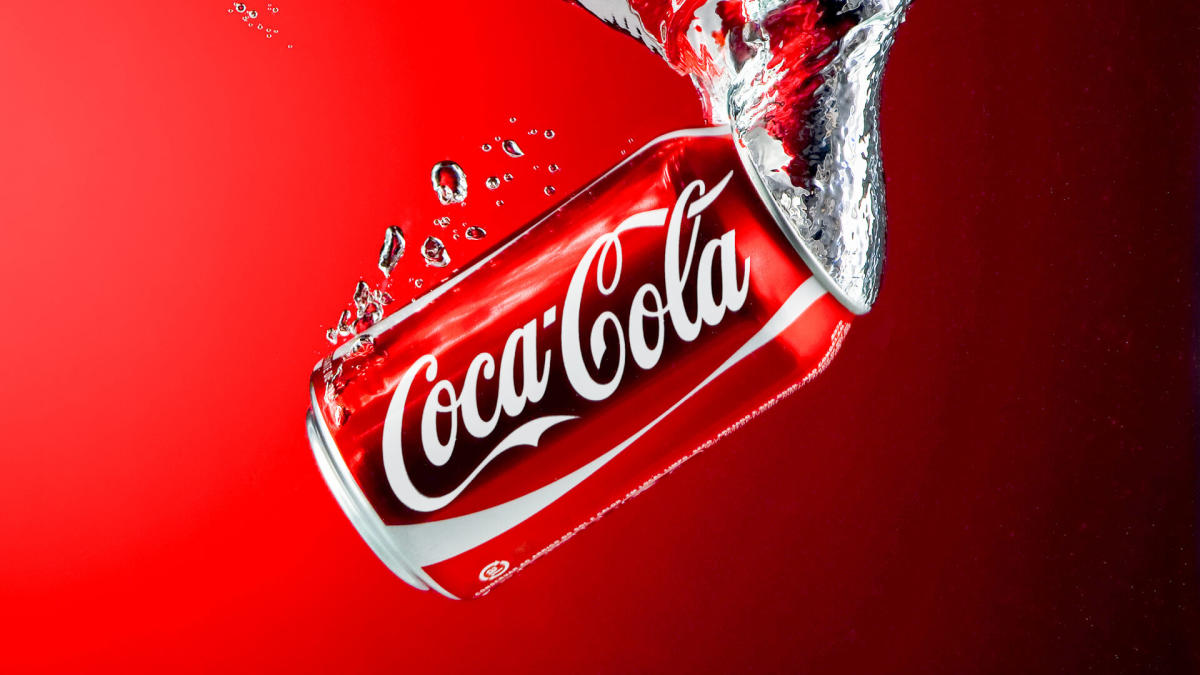
Companies with Innocent Archetype
Dove, Nestle and Coca-Cola are the most famous brands that project an innocent archetype. They like to spread happiness throughout the world, and offer products that make you joyful.
Companies with Jester Archetype
Godaddy, Pepsi, MAilChimp and Doritos encorporated humor and playfulness into their brands, often teasing their competitors and bringing laughter to their audience and customers. They are Jesters and do a great job showing it.
Companies with Magician Archetype
Disney, Sony, MAC Cosmetics and Snickers are brands with Magician archetype that entertain and amuse their audience with their magical powers.
Companies with Ruler Archetype
Mercedes Benz, Boss and Harley Davidson are best examples for the Ruler archetype. When you are using their product, you are sending a message to the world that you are the boss.
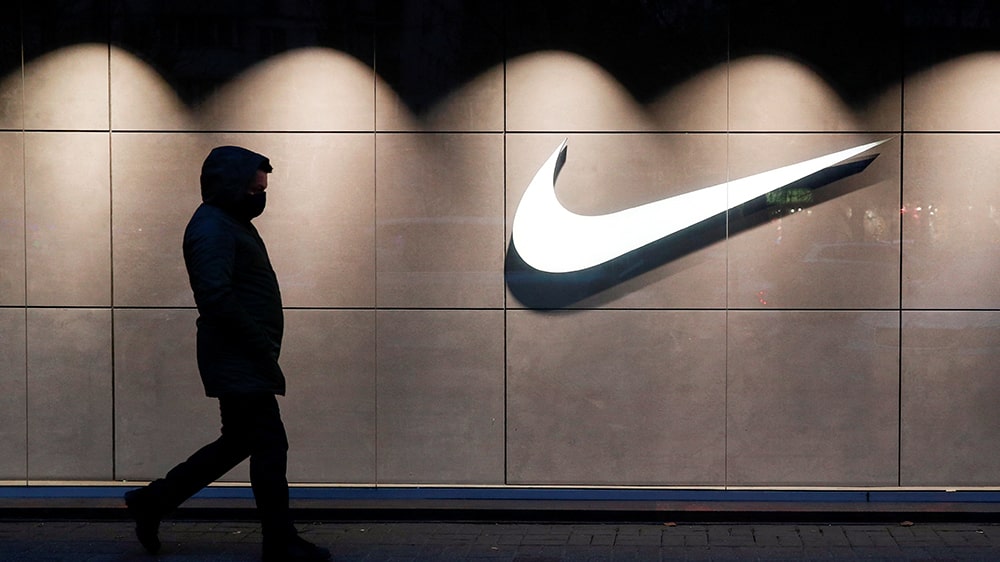
Companies with Hero Archetype
Nike, Alibaba, NBA and Fedex are Hero archetypes. These brands leave their marks on the world and inspire people to the best version of themselves by using their products. They are symbols of achieving greatness through hard work.
Companies with Everyman Archetype
Brands Like IKEA, KFC and eBay and Target are brands with the Everyman archetype. They offer quality and affordable products for everyone. They include everyone into their branding and leave no man behind.
Companies with Rebel Archetype
Paypal, AirBnB and Virgin Mobile challenge the traditional market and offer a new, easy and accessible solution that disrupts the market. They are truly Rebels that stand above traditions.
Companies with Explorer Archetype
Jeep, Starbucks, NASA and GoPro are best examples for the explorer archetype. Not only do they go above and beyond known borders, they also encourage their audience to go out there and explore the world.
Companies with Lover Archetype
Victoria’s Secret, Chanel and Calvin Klein are Lovers. They offer luxurious and sensual products and help people to deepen their connections with each other and create meaningful bonds.
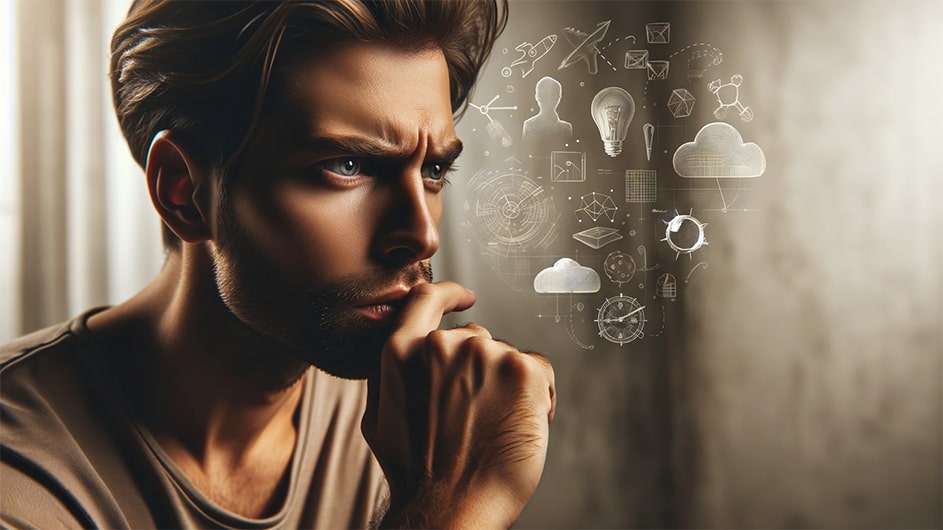
Why are brand archetypes important?
Every brand has a message that they want to convey to its customers. Archetypes help the brand to establish values and convey messages to the subconscious of peoples. In fact, archetypes give your brand character, and let people to understand and interact better with the brand.
Therefore, archetypes play a major role in establishing a long lasting and quality relationship between the brand and customers. On the other hand, having an archetype allows the brand to tell a rich and meaningful story, thus preparing the audience for establishing emotional connections, which at the end creates loyal customers.
How to choose a brand archetype?
Now you might be wondering, how can you choose an archetype that fits with your brand? Well, there are 3 things you need to consider:
Core values and missions
Depending on the brand’s industry, archetypes can be easy to identify. For example if you have a product that is related to adventure, “Explorer” can be a good archetype, or if the brand belongs to an online academy, teaching marketing and design, “Sage” archetype would be ideal. But in most cases, things are not that easy. You must define the brand’s core values and missions first, and align them with archetypes patterns. In other words, to determine the brand archetypes, you must first answer the why behind your brand.
The Audience
You must know your audience in order to choose the perfect archetype to communicate with them. To do so, you can define segments and create personalities for them, and then choose the archetypes that are most aligned with their needs and desires.
Emotions
Archetypes can create emotions in the audience, therefore you need to be very clear about how you want to feel about your brand. For example, if you want your audience to feel empowered, you can choose the “Hero” archetype.
Aligning marketing strategy with brand archetype
When you decide on your brand’s archetype, it’s time to harness its power in your marketing strategy. Your marketing efforts should align with your brand’s archetype and create a cohesive brand presence. To do so, you need to follow these steps:
Define goals
Understand your archetype’s specific traits and define your goals according to them. For example if you are a Creator, your goals should promote creativity and celebrate those who are stepping outside of their comfort zone to create something new.
Create content
Your promotional content should be in character with your archetype’s traits. The content type and tone should reflect these traits throughout campaigns and your audience must feel inspired.
Marketing Channels
You must choose marketing channels according to your archetype. By focusing on the right channels, you increase the chance of creating deeper connections with your audience.
Measure the success
You should be able to measure the success of your archetype in marketing efforts. For example if you chose the jester, you can monitor your content on social media to see if people are reacting positively or not.
Difference between archetypes and persona
So with what we told about archetypes, you might be wondering what is the difference between archetypes and personas? They both project an image to customers. While that is true, there are some structural differences between personas and archetypes.
Persona determines the tone and voice the brand wants to use to communicate with customers. It is detail-oriented and data-driven and used during the research phase.
Archetypes determine the brand’s behavior and provide a symbolic perspective to the audience, and are used during the strategy-setting phase.
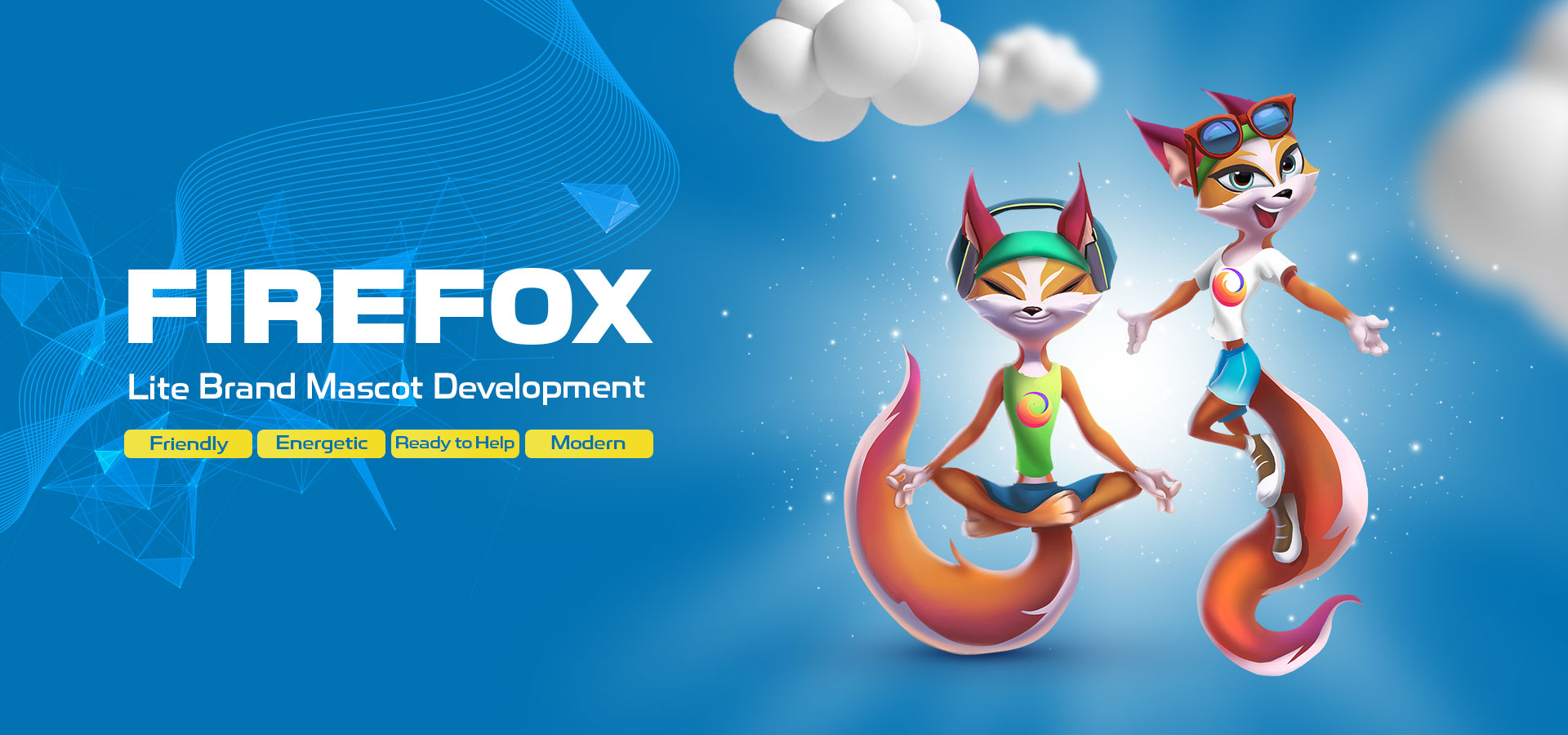
How Dream Farm Agency Can Help You Take Advantage of The powerful nature of brand archetypes
Brand archetypes use familiarity to put an image into the audience’s mind, and they use it through symbolism. This gives archetypes the power to control the narrative, and transcends messages from screens and papers into people’s hearts and minds.
One of the tools that helps brands apply the archetypes is through brand mascot and powerful visuals.
As I mentioned before, Archetypes are all about symbolism, and mascots are symbols, representing the brand.
Dream Farm Agencies experienced designers with deep knowledge of branding helped dozens of brands Like Firefox and Dish to bring their brands to life.
The Creative Digital team in Dream Farm Agency uses advanced visuals and storytelling to give depth to your brand’s archetype and help you implant memorable and lasting images in your audience’s minds.
With Dream Farm Solutions, you can trace your message through screens and papers into your audience’s minds and hearts.
You can read more about our Brand Mascot solution here: Brand Mascot

Rojan
